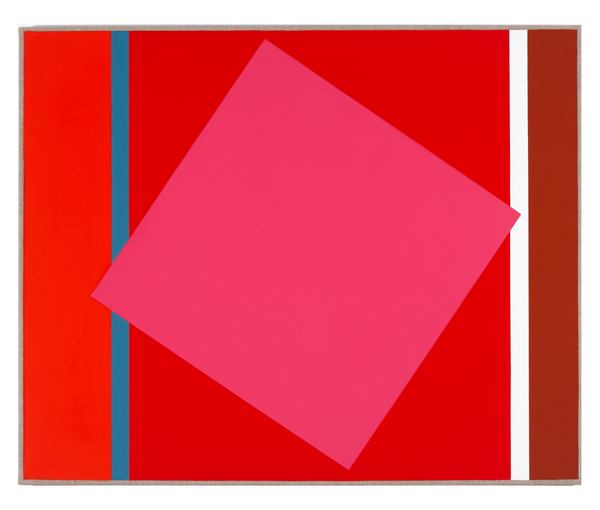From Andrew Frost…
When an artist sets limits on their painting they’re setting themselves a challenge. They might paint only in a certain colour and at a particular size, they might stick to a single subject or theme. In minimalist painting it seems that it’s all about reduction – taking things down to a simple set of variables and exploring elements such as pattern, repetition and colour. In Virginia Coventry’s latest body of work the set of variables are plain to see but, within this seemingly limited set of choices, her work has the majestic logic of music.
Coventry’s paintings play with light and colour and their interaction with the viewer’s eye. Large blocks of colour, some set in squares with subtle variations of placement and framing lines, set up a slowly but dramatically modulating pulse across the works. The series Nerrim I-IV – that look like their composition has been lifted from the design of old floppy discs – use shifts in grey, brown, blue, black and white to create a visual progression akin to the crescendos of techno, while the variations of works such as Two Yellows, Pink Red and White Grey have the elegant simplicity of the music of La Monte Young. Coventry’s interest in the ‘acoustics of colour’ is more than just an analogy between the aural and the visual, it’s a full embrace of the tantalizing possibilities of the synaesthetic experience.
Until November 1
Liverpool Street Gallery, East Sydney
Pic: Virginia Coventry, d. Pink Red, 2011. Vinyl, acrylic on Belgian linen, 65x80cm. Courtesy of the artist and Liverpool Street Gallery.



Virginia Coventry’s painting echo the discourses of Greenberg. Like the heroics of modernisms last gasp, this painting too has hit the wall of its own materiality- aka Art for Art’s sake. Coventry has not moved from this position. The painting sits imperial, asking of its audience as in Ad Reinhardt’s cartoon of his painting snidely asking in relation to the viewer, ‘What do you represent?’ For this viewer, this painting represents a dissociated, alienated and exhausted thesis and these works do not extend the history of painting from post war American art to the present, they unnecessarily respect it.
Coventry conflates the formalist oeuvres of Barnett Newman Zip painting and Josef Albers Homage to a Square and oh yeah throw in a bit of Romanticism with Kandinsky’s synesthetic musings, on sound and vision. In Australia, and other post-colonial countries, we have the licence to play with imperialist histories. But I fear that Coventry would not like a satirical and ironical reading, as hers is a ‘serious’ art and should be read as the last word on modernisms aggrandising tenets.
Having said that and in the obverse, what is truly and genuinely beautiful about this episode in her career, and previous shows, is her precision with composition. She has an impeccable eye for formal construction in the application of colour and shape. She has a craftsman eye of the highest quality. The relationships in and passages of paint in her compositions are a joy to traverse. The tensions in the planes of colour optically resonate and are intellectually ingenious. She makes a great product. The formal purity of her painting is the triumph of her practice and that makes her a good artist, not the poetic content that the reviewer and artist has referenced in titles and statements. It would do abstract painting and hers a disservice to say that it had any worldly anchors.